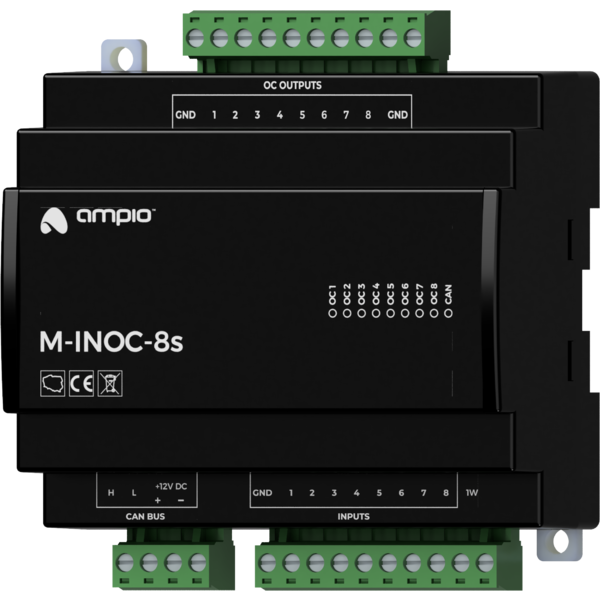M-INOC-8s: Module with eight bi-state inputs and eight OC outputs
M-INOC-8s
Tags:
- Access Control,
- Air conditioning,
- Ampio CAN modules,
- Ampio Cloud,
- Analogue control,
- Central heating,
- CON Family,
- Dali,
- Dallas 18B20,
- DIM Family,
- Dimmer,
- DIN Rail modules,
- Display,
- DOT Family,
- Hotel,
- IN Family,
- Input Modules,
- Integrations,
- IP,
- Junction Box modules,
- KNX,
- LED Family,
- LED lights,
- Lights,
- Mobile App,
- Modbus,
- Node-red,
- OC Family,
- Open Collector Drivers,
- OUT Family,
- Output modules,
- OWA Lighting,
- OWA lighting bus modules,
- RDN Family,
- REL Family,
- Relay Outputs,
- RFID,
- RGBW Lights,
- Roller shutters and blinds,
- RS-232,
- RS-485,
- SATEL,
- Security,
- SENS Family,
- Sensors,
- SERV family,
- Touch panels,
- Wall Switch

Technical data
Dimensions
Environment
The image above is for illustration purpose only. The actual module may vary from the one presented here.
General features
Module M-INOC-8s is a component of the Ampio system. Required voltage to power the module is 11 — 16V DC. The module is controlled via CAN bus.
The module has eight ground-detecting inputs, eight OC outputs, and a 1-Wire interface.
OC outputs
The module has open-collector outputs allowing for smooth control of resistive loads supplied with voltage of up to 40V DC. It is also allowed to control loads of moderate inductive nature, in particular relays. Control is performed by the method of pulse-width modulation (PWM). Internally, each of the outputs allows the connected line to be short-circuited to the module’s ground.
Ground detecting inputs
The module has inputs that go into the active state when they are shorted to ground. They can be used in the case of any devices with potential-free contact outputs, e.g. wall switches, reed switches, buttons, switches, etc. They can also be used for integration with devices with potential-free relay outputs or optocoupler outputs with a collector voltage greater than 12V.
Temperature sensors
The module is equipped with a 1-Wire interface connector that allows to connect up to 6 digital Dallas DS18B20 temperature sensors. The temperature measurement result is available for all devices operating within the building automation bus. It may turn out to be particularly useful for purposes related to temperature regulation, or to present the measurement result on touch panels and in a mobile application.
The total length of the 1-Wire bus cable to which the temperature sensors are connected cannot exceed 15m.
Typical application
- Control of resistive loads supplied with voltages up to 40V DC, e.g.:
- LED lighting,
- piez- buzzers,
- heating mats;
- control of relays;
- connecting classic light switches or other devices with potential-free contact outputs;
- integration with devices with potential-free relay outputs;
- integration with devices with optocoupler outputs;
- room temperature measurement.
Installation
The module is designed for mounting on a 35mm DIN rail. The module’s width is 105mm, 6 spaces/modules in DB. In order to start the module, it must be connected to the CAN bus. The bus of the Ampio system consists of four wires – two for power and two for communication between the modules.
In addition to the CAN bus interface, the device has two connectors with screw terminals. They allow for the connection of eight signal lines to ground detecting inputs, eight resistive loads to open-collector outputs, and up to 6 digital Dallas DS18B20 temperature sensors.
When using the open-collector outputs functionality, it should be borne in mind that the supply circuits of the connected loads are closed by the mass of the module. Therefore, it should be ensured that the mass of the device is connected to the mass of the power supply with a cable of appropriate thickness.
If the current consumed by all loads connected to the open-collector output is lower than 16A, it is sufficient to connect one ground terminal to the external power supply. With two terminals connected, the maximum current is 32A.
Device status LEDs
On the front of the module there are signalling LED indicators. The green LED with the label CAN indicates the status of communication on the CAN bus:
- one regular flash every 1 sec. – CAN bus communication is working properly,
- two regular flashes every 1 sec. – the module is not receiving information from other modules,
- three regular flashes every 1 sec. – the module cannot send information to the CAN bus;
Apart from the LED that indicates the communication bus status, on the front of the device there are 8 red LEDs indicating the status of the OC outputs.
Programming
The module is programmed with a special programmer, available for authorised technicians, and the Ampio Smart Home CAN configurator software. It allows you to modify the parameters of the module and define its behaviour in response to signals directly available to the module as well as general information coming from all devices present in the home automation bus.
Module dimensions
Dimensions expressed in millimeters.
